Nora Chipaumire premieres a new work at Montclair State University’s Peak Performances.
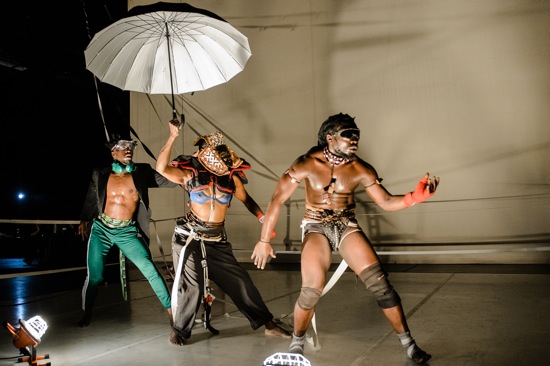
Nora Chipaumire’s portrait of myself as my father. (L to R): Shamar Watt, Nora Chipaumire, and Pape Ibrahima N’diaye. Photo: Gennadi Novash
You go out to Montclair State University to attend the world premiere of Nora Chipaumire’s portrait of myself as my father on Peak Peformances’ 2015-2016 season, and note that Spring is greening the lawns. The immense construction machines that are ripping up turf and erecting buildings sit brooding and silent. Students in black-and-white clothing politely usher you to your seat in the Alexander Kasser Theater.
And then all hell breaks loose. Before long, virtual shards will be flying around, labeled “kinship,” “racism,” “colonialism.” “empowerment,” and more. For now, a hulking figure of indeterminate gender stands on a platform confronting us. A towel covers its head, football pads protect its shoulders; its belly is bare above baggy gray pants; it wears sneakers. It grunts and growls and mutters to itself as late-comers take their seats, then, in a deep, accented voice, advises us to turn off our cell phones and refrain from taking photographs.
This is a clue to what may follow: humor and irony will creep in under violence, under anger.
As the lights brighten, it’s clear that the stage has become an arena for prizefighting, although its defining ropes are elastic white tapes, and other tapes and cords—mostly black—lie or hang in unruly ways. Chairs for the contenders in two corners are bright red. On one of these is slumped a man, legs spraddled, foregrounding what looks like a very large zipper securing his black trunks. He looks as if he’s just finished a round and is waiting for someone to bring him water and rub his muscles. This is Pape Ibrahima N’diaye (aka Kaolack). That someone could be (but isn’t) Shamar Watt. He, too, is dressed crazily; an unbuttoned black tailcoat atop green sweatpants, a gold headband confining a nest of tiny dreadlocks. Over the course of portrait of myself as my father, Watt will function as a kind of stage manager, moving and rearranging floor spotlights and echoing or supporting the action.
This is what you might call a postmodern stew. We hear English spoken (in soft voices or strident ones), also French, Wolof from Kaolack’s birthplace in Sénégal, and Shona from Chipaumire’s native Zimbabwe. Fragmentation is key. The music and sound score created by Philip White unsteadies us.
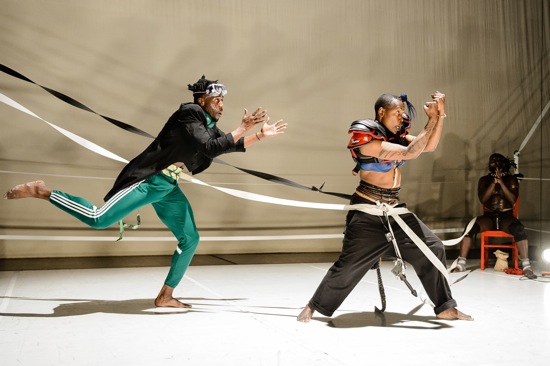
Shamar Watt and Nora Chipaumire. At back, Pape Ibrahama M’diaye (aka Kaolack). Photo: Gennadi Novash
After a while, it becomes evident that there is to be no fighting between the performers. They punch the air and the shadows within it—among them the shadows that might deny a black African male his power, his voice. Chipaumire knew her father, Webster Barnabas Chipaumire, only in the years leading up to her fifth birthday, and he died in 1980 at the age of 42. She has re-fashioned him as champion athlete and boxer—a Muhammed Ali, if you will, but the strike-through of his name in the title suggests his effacement as a man and a father. In her printed statement, she says, “I have given him boxing gloves so that he has a fighting chance. I have put him in a boxing ring to do battle with himself, his shadow, his ancestors, the industrial gods, and that merciless tyrant: progress.”
From time to time, Watt holds up a sign announcing “Round One.” Round Two never arrives. At times, a bell sounds—usually the handbell that Watt brandishes and sometimes can’t stop ringing. Sometimes Kaolack is sinuous in his strength, whipping his hips around, undulating his muscular torso; once Chipaumire taunts him, calls him a sissy. It doesn’t take long to realize that some of the cords run up to high offstage anchorage, but some connect Kaolack and Chipaumire. This umbellical bond that crosses the gender barrier is almost as prone to tangling as the real thing. Kaolack rises from a squat and begins a wide-legged walk in a circle, while Chipaumire holds and gathers in the rope that bonds them; like a ringmaster exercising a horse, she decides how much slack, if any, he can be given. Fierce as he is, he ends up running in place.
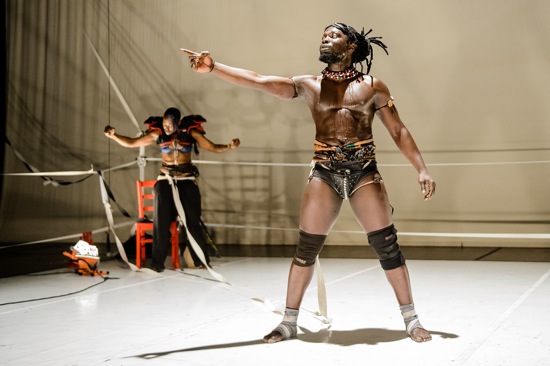
Pape Ibrahima N’diaye (aka Kaolack) in Nora Chipaumire’s portrait of myself as my father. Chipaumire at back. Photo; Gennadi Novash
Later, she tells him “Ah, you’re beautiful!” and takes a selfie, saying almost under her breath, “brought to you by iPhone.”
Chipaumire avoids what audience might label as “dancing,” but she and the men do dance—stamp and clap rhythmically, make their torsos look elastic, adopt aggressive stances, assume solid balances, lunge, kick. They’re primed to stand proud, but ready to hunker down in a defensive stance. Once, Watt enters the action with a gigantic leap; he looks as if he were crossing a river in a single bound. They also talk, goad one another, or argue. Questions are asked of no one (or us). “How do you become a man?” “How do you become a black man?” “How do you become a black African man?” Advice is given: “You better know how to fuck” and “You better know how to die.”
There are cataclysms of sound and light. Once, these mimic a power out, with all its crackling blackness. Suddenly—I forget just when—one of the men rushes at the side rail and stretches it beyond its supposed limit, causing disarray among the other binding and defining barriers.
At the end of this fascinating, messy, entangling work, Chipaumire walks slowly around carrying Kaolack piggyback. “What is this about? Watt asks her. Her only answer is the name “Webster Barnabas Chipaumire” and the sentence, “I carry the carcass of my father.”
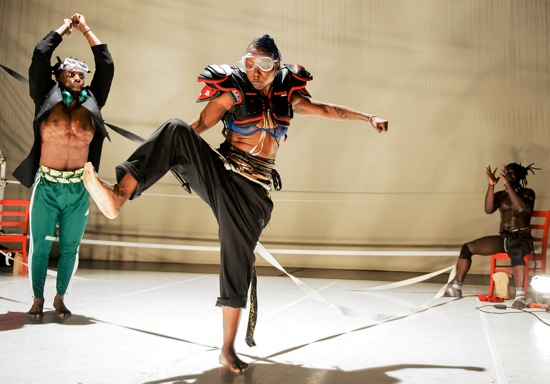
(L to R): Shamar Watt, Nora Chipaumire, and Pape Ibrahima N’diaye in portrait of myself as my father. Photo: Gennadi Novash
portrait of myself as my father is followed by a masterful short film, Afro Promo #1 Kinglady. This was produced at Montclair State through its Office of Arts and Cultural Programming, one of whose components is Dance for Film on Location at MSU (a project of the Andrew Mellon Foundation’s Choreographers on Campus Initiative). Chipaumire directed and choreographed the film, with Benjamin Seth Wolf as Director of Photography and Alla Kavgan as Editor. The soundscore is taken from Music for Merce, an anthology related to Cunningham Events that includes work by such composers as Takehisa Kosugi and Christian Wolff.
Here Chipaumire takes a slightly lighter swing at what she’d have the black man she has embodied, encouraged, and castigated onstage be up for. He needs instruction on how on how to swagger, she tells us, and how to become a super hero. Watt is in the film with her—more or less in the background, although the camera shows us a close-up of two pairs of feet in red sneakers dancing with bold abandon. Chipaumire’s handsome face, sometimes framed in a glowing circle within the rectangular frame, spits out the words as if she were chewing them up for us. She also dances in a small “room” whose walls—by turns yellow, red, or blue—are light-weight, minimally moving, fabric with tiny flowers on it (Art Director: Peter Born). It’s daintiness contrasts smartly with her sensual ferocity.
The woman that she is onstage, embodying the man she would like her father to have been, is fierce enough for you to adore, even as you wonder whether you’d dare to meet her face to face.
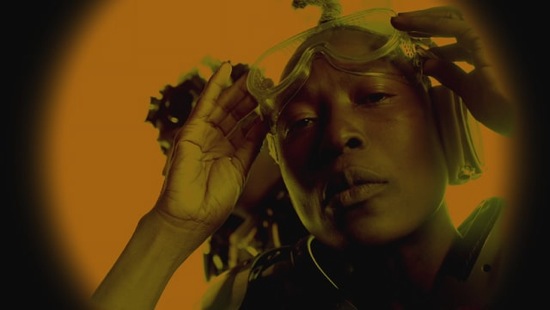
Nora Chipaumire, from the film Afro Promo #1 Kinglady

Having seen this work (and on the night you were there) I marvel at your ability to rise to the challenge of writing so lucidly and compellingly about this fierce piece. Golden Gloves to Deborah!
The work was all you described and more – Deborah – You always write so brilliantly – one of the most amazing moments was the shadow world that Nora, Kaolack and Shamar created. When I walked into Montclair’s lobby space, there stood ancient African statues encased behind glass and at the top of the show, Nora stood costumed, in the dark, but for a light that projected her shadow at that ancient statue wrapped and virile as both woman and man – breasts and penis. A chilling moment that started the rampage. It’s a must piece of work to see – Nora breaks it down for us in a powerful way.
I’m so happy that Catherine made this connection between those dark, lean wood carvings displayed in the theater’s lobby and the opening image in Chipaumire’s work. The ancestors loomed within it.